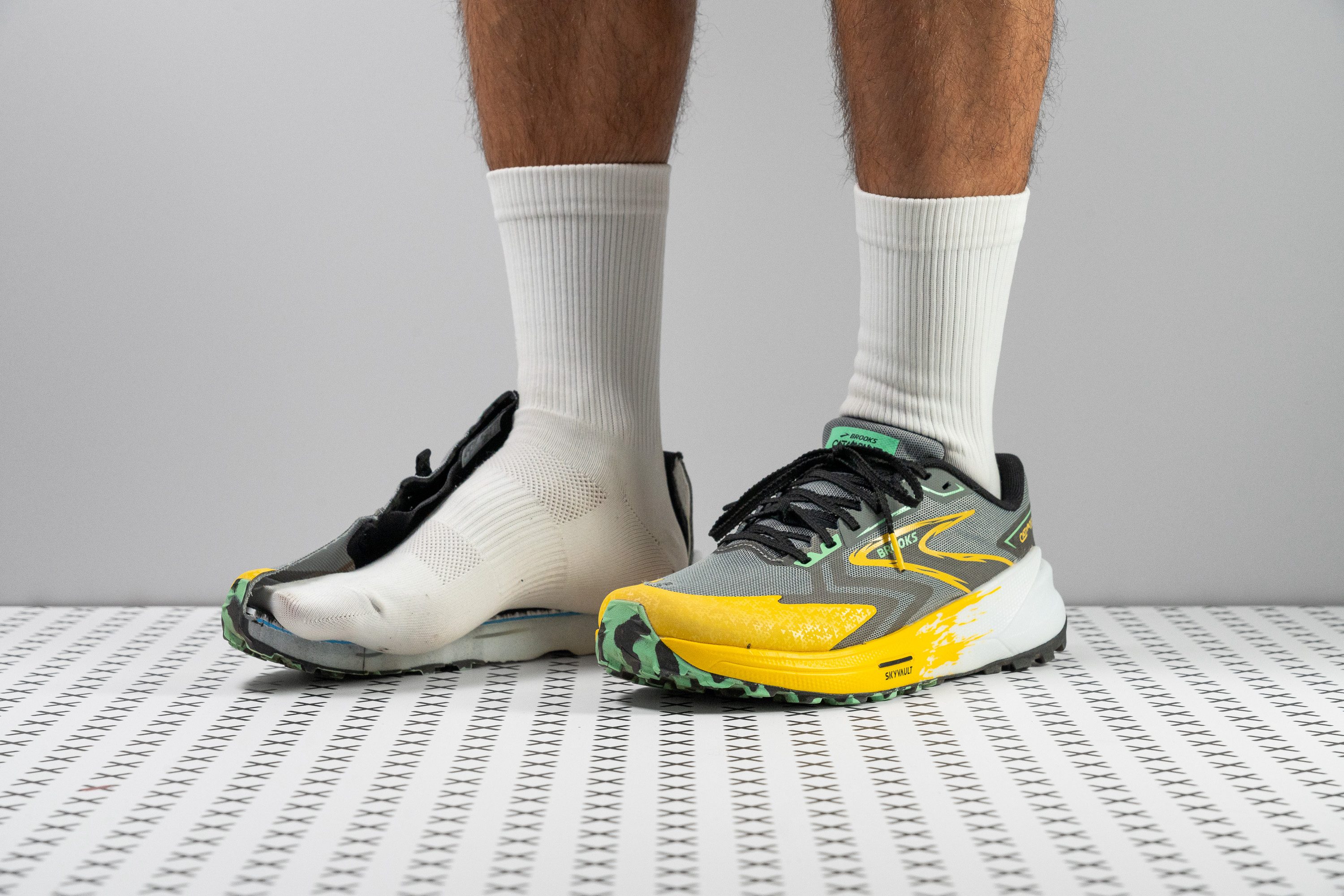Our verdict
- Our top pick in best Brooks trail running shoes
Pros
- Reduced weight from v2
- Enhanced flexibility
- Stable and secure ride
- High-quality materials
- Suitable for all footstrikes
- Lightweight!
- Fantastic Skyvault plate
- Adaptable across various paces
Cons
- Poor upper ventilation
- Tight fit for some
- Limited grip in wet conditions
Audience verdict
- Top 8% in trail running shoes
- Top 12% in Brooks running shoes
Comparison
The most similar running shoes compared
+ + Add a shoe | |||||
|---|---|---|---|---|---|
| Audience score | 90 Superb! | 85 Good! | 86 Great! | 78 Decent! | |
| Price | $170 | $145 | $150 | $75 | |
| Trail terrain | Light terrainModerate terrain | Light terrainModerate terrain | Light terrainModerate terrain | Light terrainModerate terrain | |
| Arch support | Neutral | Neutral | Neutral | Neutral | |
| Weight lab Weight brand | 9 oz / 255g 9.4 oz / 266g | 8.8 oz / 250g 8.8 oz / 250g | 10.1 oz / 286g 9.2 oz / 260g | 9.8 oz / 279g 10.3 oz / 292g | |
| Drop lab Drop brand | 6.8 mm 6.0 mm | 8.8 mm 5.0 mm | 7.2 mm 6.0 mm | 6.7 mm 6.0 mm | |
| Strike pattern | Mid/forefoot | HeelMid/forefoot | Mid/forefoot | Mid/forefoot | |
| Midsole softness | Balanced | Soft | Soft | Balanced | |
| Difference in midsole softness in cold | Normal | Normal | Big | Normal | |
| Plate | Rock plate | - | - | - | |
| Toebox durability | Very bad | Good | Bad | Very bad | |
| Heel padding durability | Good | Decent | - | Bad | |
| Outsole durability | Decent | - | - | Good | |
| Breathability | Warm | Warm | Moderate | Moderate | |
| Toebox width at the widest part | Medium | Medium | Medium | Medium | |
| Toebox width at the big toe | Medium | Narrow | Narrow | Medium | |
| Stiffness | Moderate | Flexible | Moderate | Moderate | |
| Difference in stiffness in cold | Small | Big | Big | Small | |
| Torsional rigidity | Moderate | Moderate | Flexible | Moderate | |
| Heel counter stiffness | Flexible | Stiff | Moderate | Flexible | |
| Lug depth | 2.9 mm | 3.1 mm | 2.8 mm | 2.9 mm | |
| Heel stack lab Heel stack brand | 28.3 mm 30.0 mm | 32.9 mm 31.0 mm | 30.6 mm 32.0 mm | 29.8 mm 29.0 mm | |
| Forefoot lab Forefoot brand | 21.5 mm 24.0 mm | 24.1 mm 26.0 mm | 23.4 mm 26.0 mm | 23.1 mm 23.0 mm | |
| Widths available | Normal | NormalWide | NormalWide | NarrowNormalWideX-Wide | |
| Season | Winter | Winter | Summer | Summer | |
| Removable insole | ✓ | ✓ | ✗ | ✓ | |
| Orthotic friendly | ✓ | ✓ | ✗ | ✓ | |
| Ranking | #25 Top 10% | #143 Bottom 43% | #117 Top 47% | #236 Bottom 5% | |
| Popularity | #191 Bottom 23% | #36 Top 15% | #140 Bottom 44% | #176 Bottom 29% |
Who should buy
We're thrilled to recommend the Brooks Catamount 3, especially after our comprehensive tests both in the lab and on the trails. We think it's:
- Perfect for runners seeking less cushion than maximalist models offer, but more than minimalist designs.
- A dream for fans of the Catamount 2 looking for enhancements in their favourite trail kick.
- Great for those who need a stable but decently cushioned shoe that can handle multiple distances and speeds with ease.

Who should NOT buy
Despite multiple upgrades, the engineered mesh upper of the Catamount 3 lacks sufficient ventilation for summer. In our experience, it's not the best choice for hot weather runs. We think a better alternative is the Hoka Speedgoat 5, which is designed to handle higher temperatures effectively and delivers a similar running experience.
Additionally, we do not recommend the Catamount 3 for runners who prefer maximalist shoes or need a lot of foam underfoot. From our analysis, shoes like the ASICS Trabuco Max 3 or the Hoka Mafate Speed 4 offer significantly more cushioning for those who need such muscle protection.
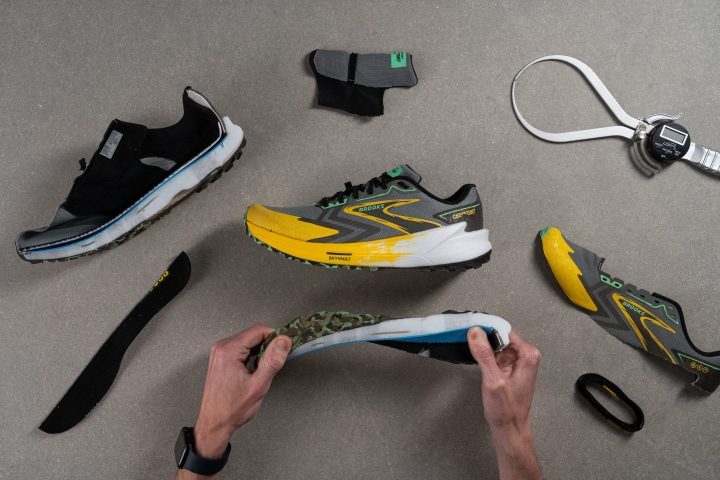
Breathability
The Catamount 3 maintain its distinctive ride experience, unchanged due to the consistent dimensions.
Our measurements revealed a forefoot width of 115.3 mm—remarkably broad given the shoe's lightweight design. We think that this wide platform contributes significantly to the shoe's nimble yet stable feel.
| Catamount 3 | 2 |
| Average | 3.3 |
Durability
Toebox durability
Our expectations were initially high, anticipating a more robust upper in the Catamount 3, so we eagerly set up the Dremel test. Sadly, the outcome was deeply disappointing, leading us to give the shoe a dismal score of 1 out of 5.
This experience highlights the crucial role of lab testing—despite initial appearances suggesting greater durability, the mesh did not hold up.
However, there's a silver lining: the toebox is well-protected by a sturdy yellow TPU layer. Despite the overall poor durability score, this protective feature should prevent most common wear issues suffered by trail shoes.
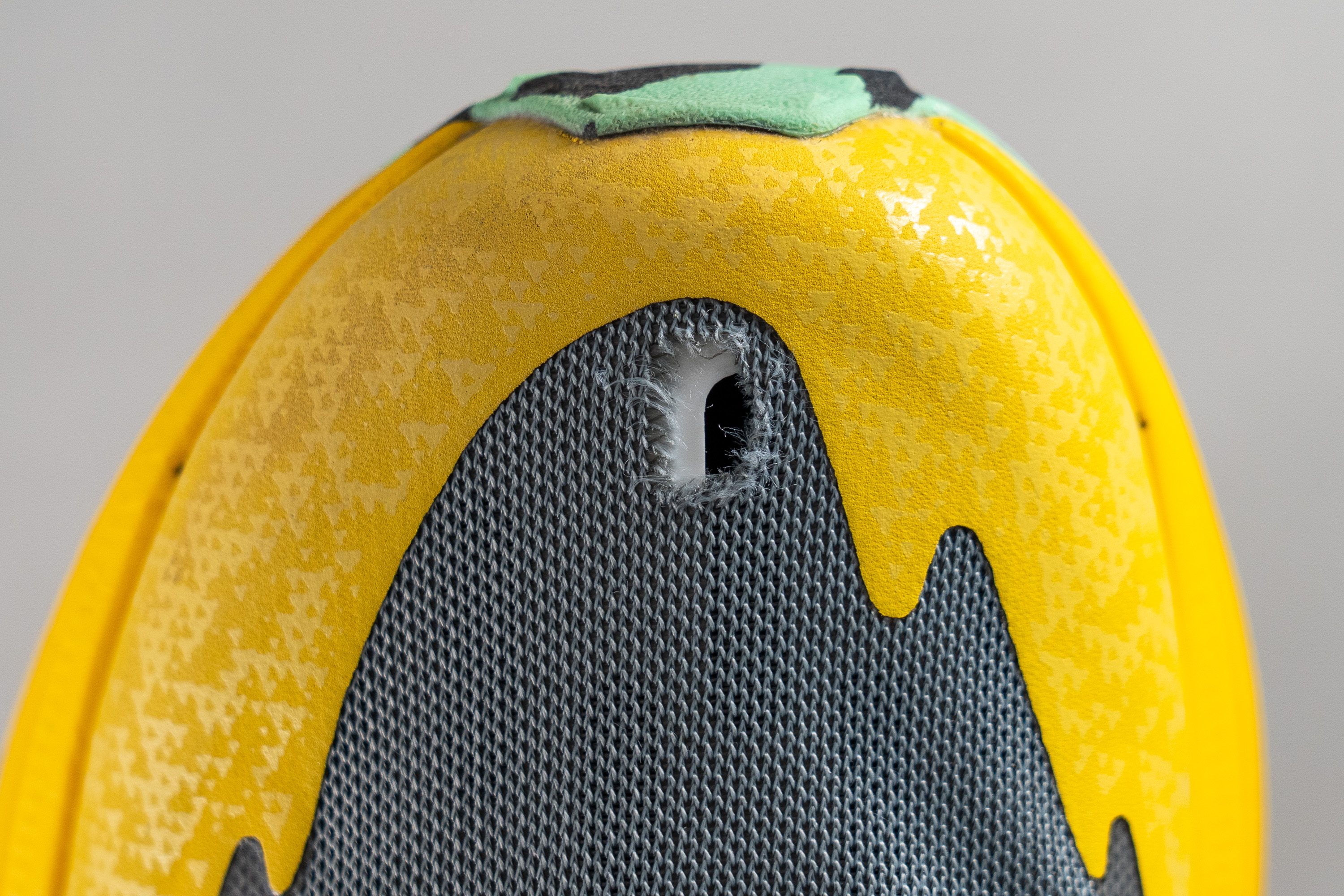
| Catamount 3 | 1 |
| Average | 3 |
Heel padding durability
We shifted our attention to the heel padding area, optimistic for a positive outcome, and indeed, we were rewarded.
The Catamount 3 showcased a significant improvement in this region, earning a robust score of 4 out of 5, leaving us pleased with its performance.
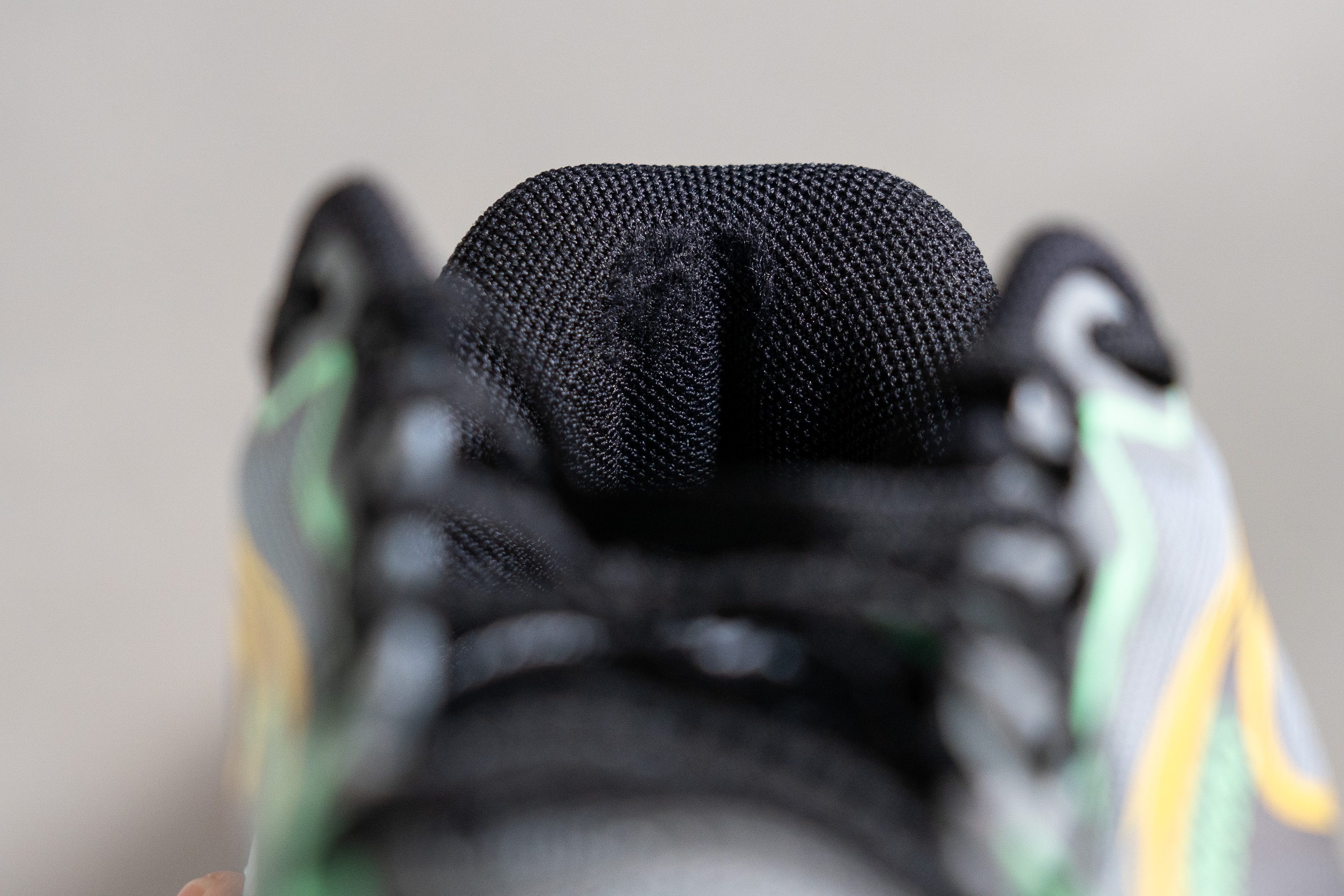
| Catamount 3 | 4 |
| Average | 2.8 |
Outsole hardness
After completing our initial durability assessments, we turned our attention to the outsole—vital for any trail running shoe. We tested the hardness of the new TrailTack Green rubber (85.4 HC) which transitions from the regular TrailTack to achieve the Carbon Neutral certificate.
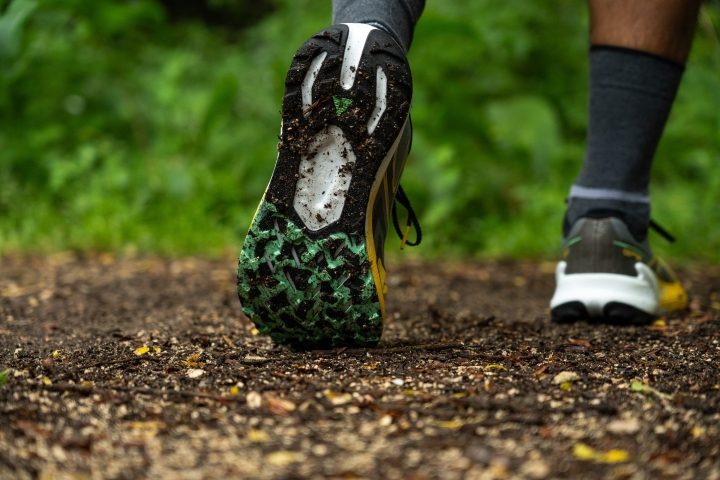
Our measurements registered the hardness at 85.4 HC, a standard figure indicating satisfactory durability and grip. While this level is acceptable in dry conditions, it doesn't match the top performance of industry leaders like Vibram.
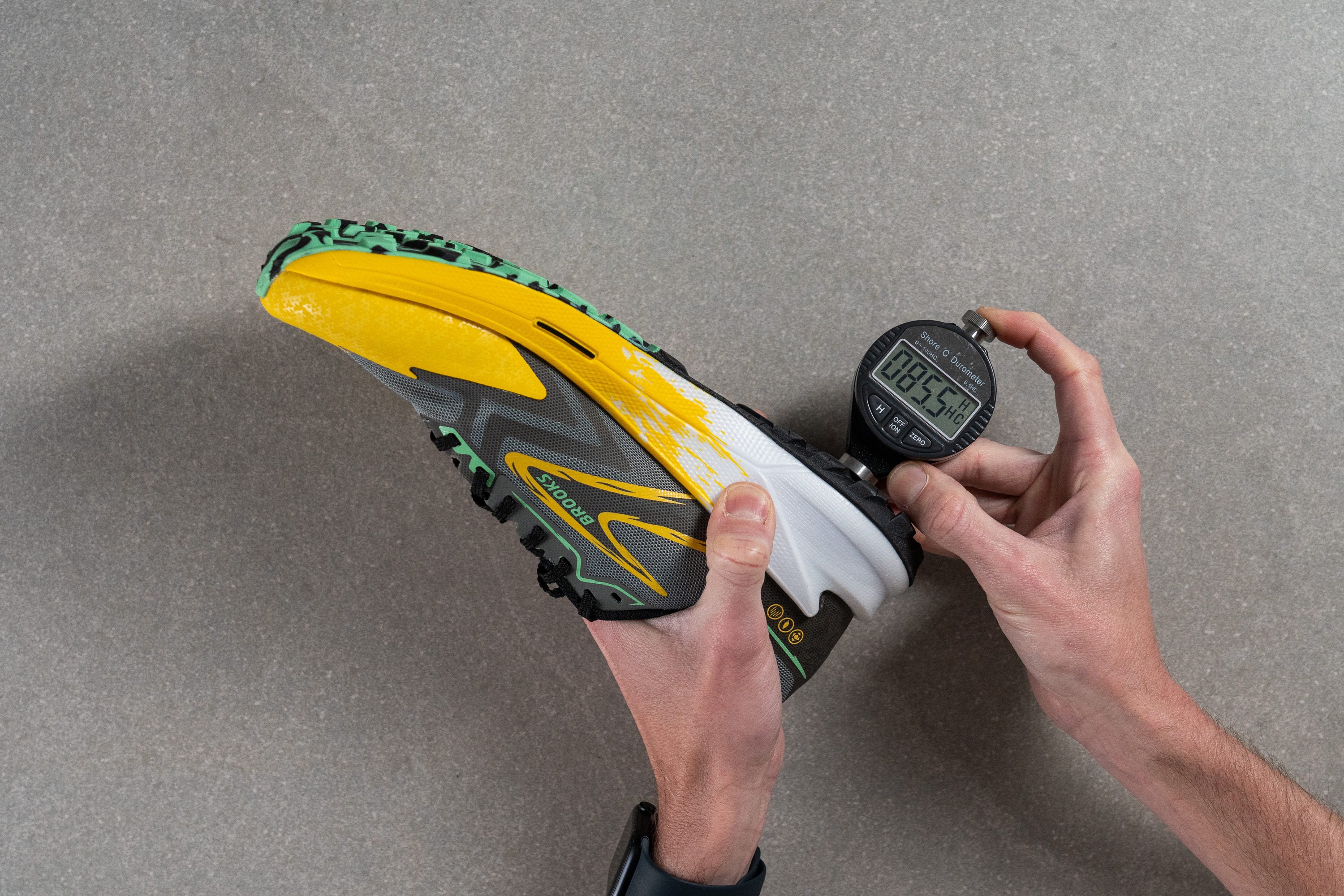
| Catamount 3 | 85.4 HC |
| Average | 85.3 HC |
Outsole durability
Our final task with the Dremel was the most challenging yet, as we increased the speed to double its normal rate to test the durability of the outsole.
Using our tyre tread gauge, we observed that the TrailTack Green rubber wore down by just 1.0 mm—a solid result that effectively removes any concerns about durability in the outsole.
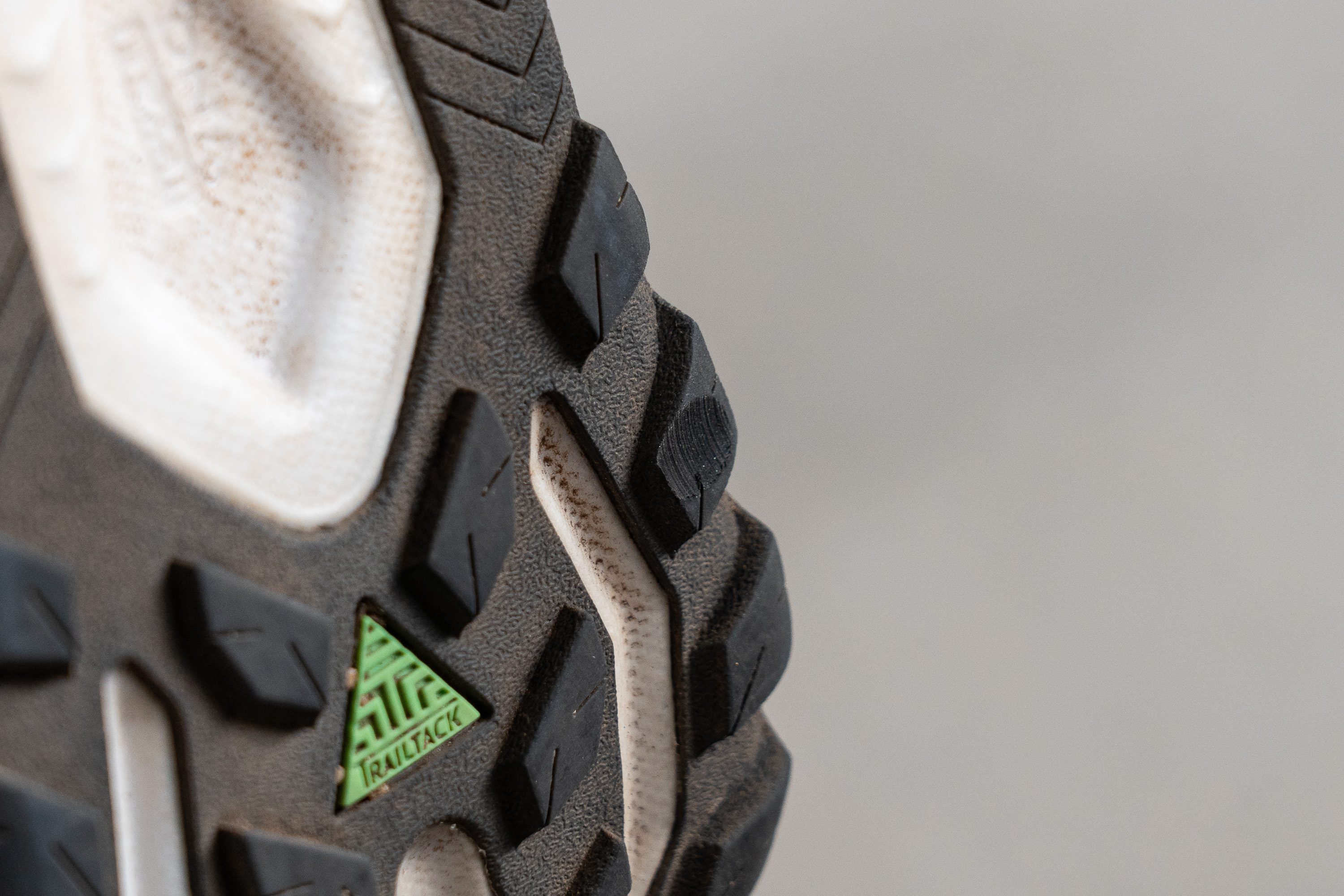
| Catamount 3 | 1.0 mm |
| Average | 0.9 mm |
Outsole thickness
Concluding our current evaluations of the TrailTack Green—with further assessments on the lugs pending—we measured the outsole thickness at 2.0 mm, striking a fine balance for this shoe design.
Given the protection of the Skyvault plate and Brooks' commitment to a lightweight design in this series, we believe they could make it even slimmer for v4.
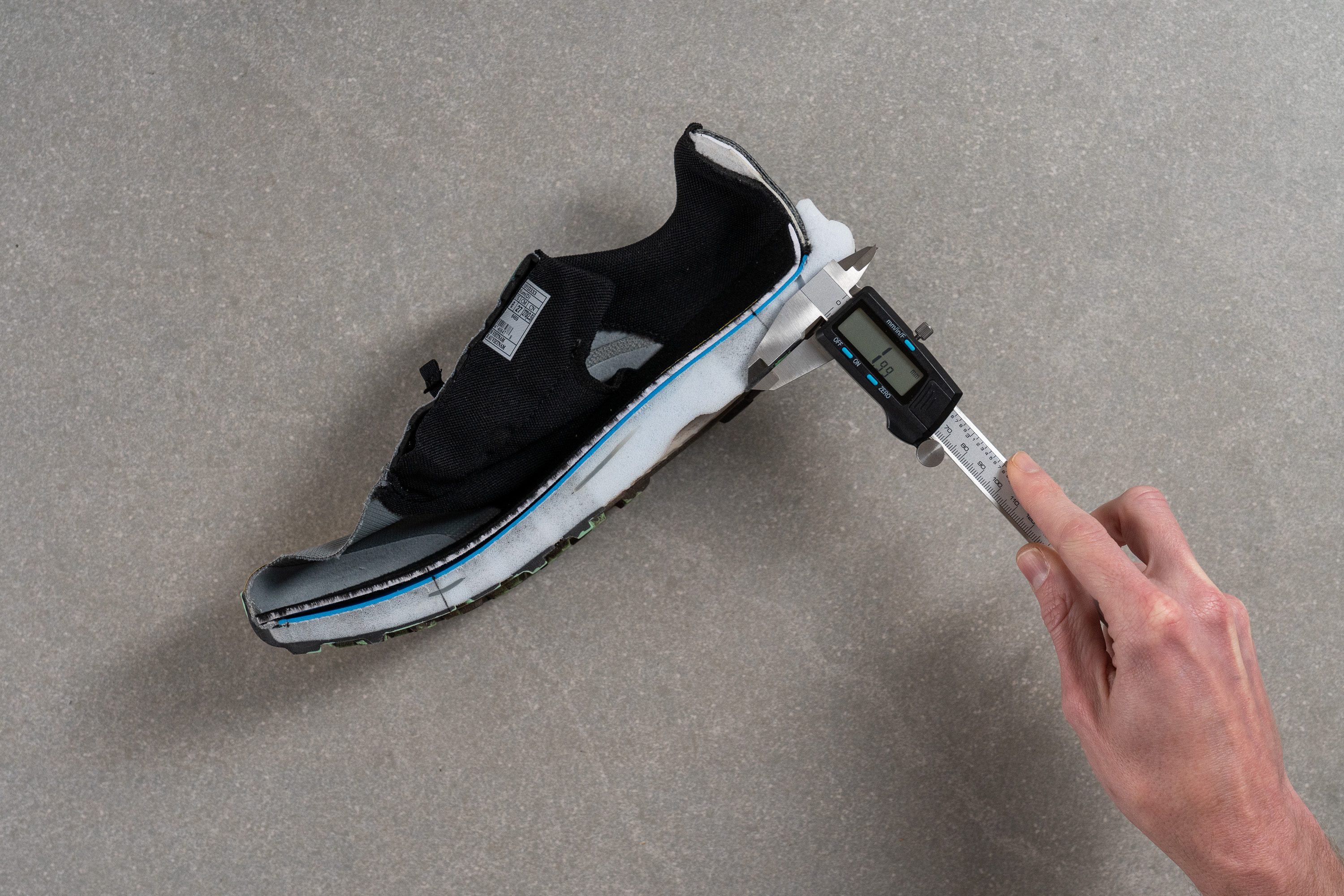
| Catamount 3 | 2.0 mm |
| Average | 2.4 mm |
Weight
One standout feature that has truly impressed us in the lab with this update of the Catamount is the weight reduction from v2. Brooks has done a remarkable job by reducing the shoe's weight by 0.7 oz, bringing it down to an amazing 9.0 oz or 255g!
This lighter update is perfect for those who prefer a featherlight ride, or for runners who thought the Catamount 2 was a tad heavy for the cushioning it offered.
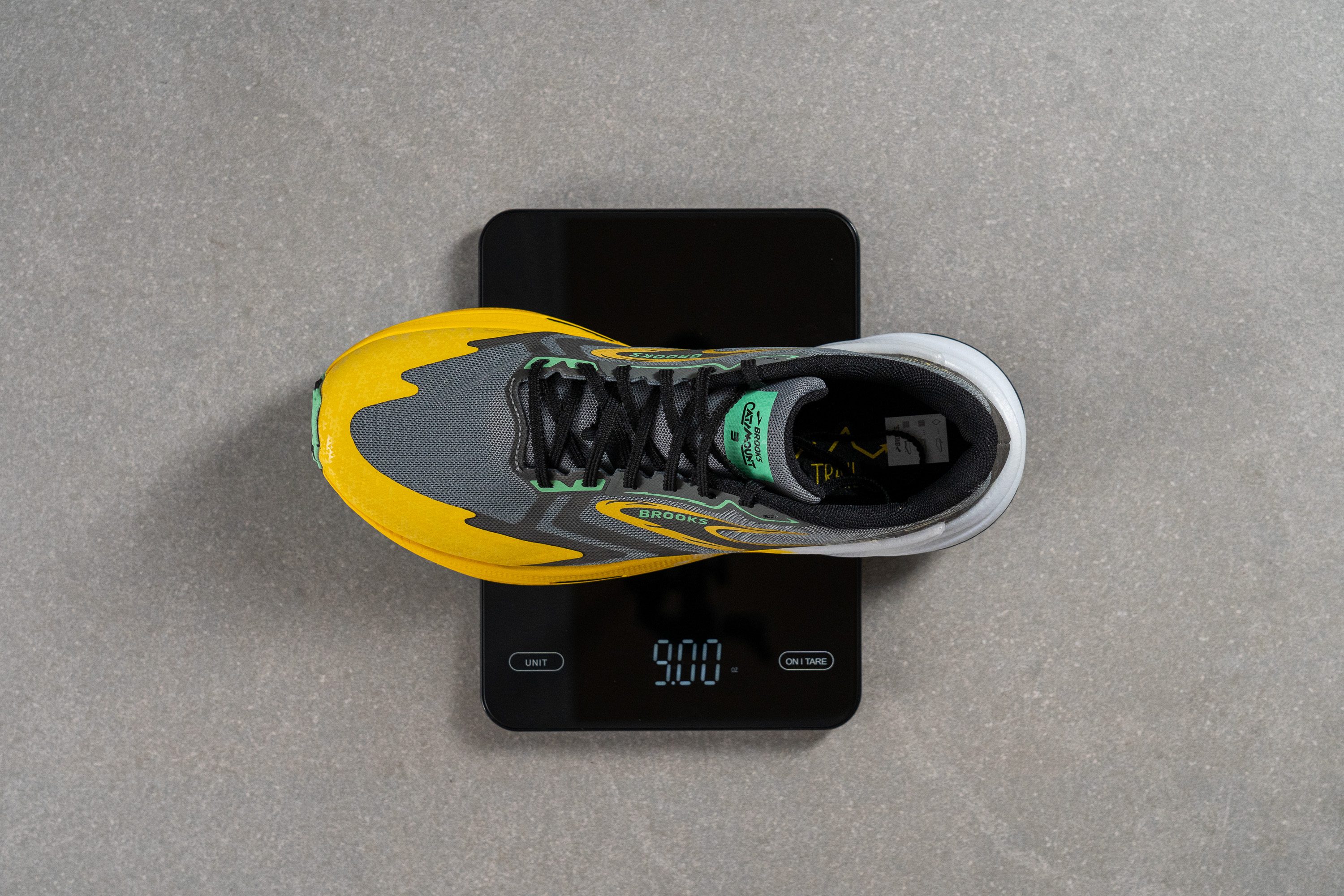
| Catamount 3 | 8.99 oz (255g) |
| Average | 10.34 oz (293g) |
Cushioning
Heel stack
Beginning our evaluation with the stack height, we positioned our callipers at the heel and recorded a modest 28.3 mm.
This sub-30-mm measurement positions the Catamount as a notably grounded option, superb for runners seeking a practical, non-maximalist shoe. This streamlined profile is perfect for those who prefer a closer connection to the trail.
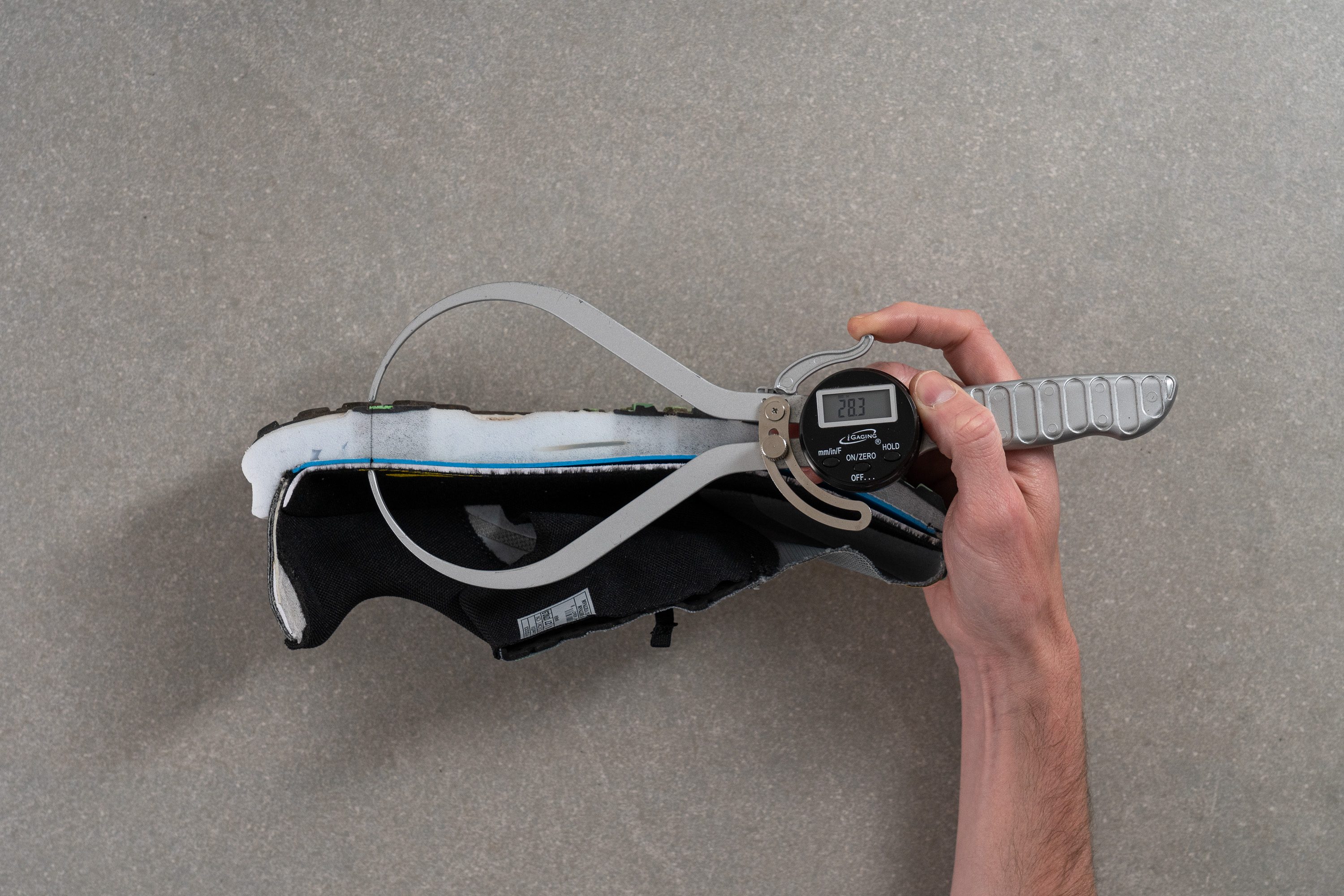
| Catamount 3 | 28.3 mm |
| Average | 32.2 mm |
Forefoot stack
Continuing to the forefoot, our measurement showed a modest 21.5 mm stack height, further emphasizing the shoe’s commitment to a moderate-to-low design philosophy in an era dominated by ultra-high, maximalist models. There's still hope!
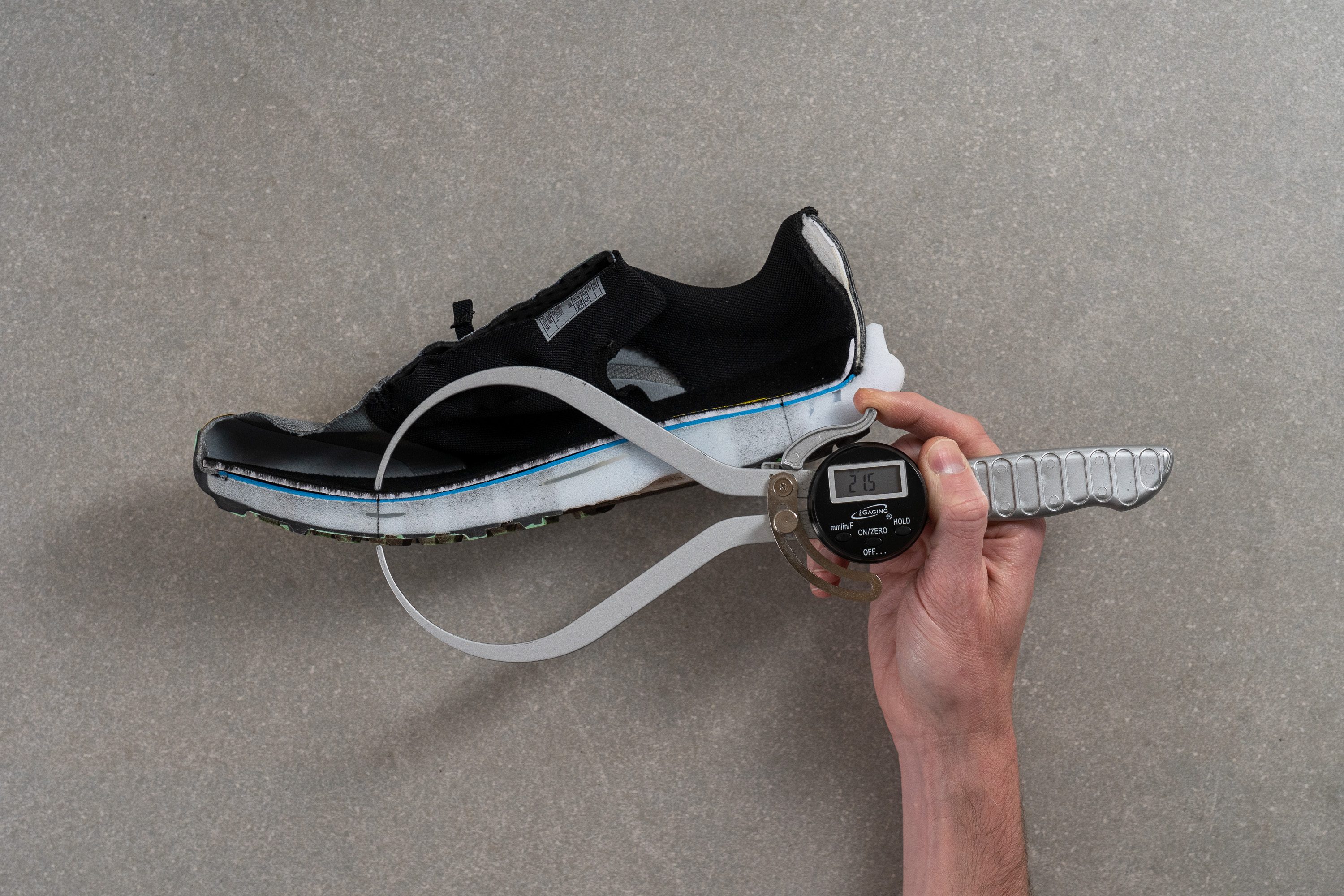
| Catamount 3 | 21.5 mm |
| Average | 24.4 mm |
Drop
The discrepancy between both measurements reveals a 6.8-mm drop, a versatile design that accommodates all runners but particularly benefits those with a midfoot strike.
Impressively, we also discovered that the actual drop deviates by less than 1 mm from Brooks' advertised specifications, a rare accuracy that we highly commend.
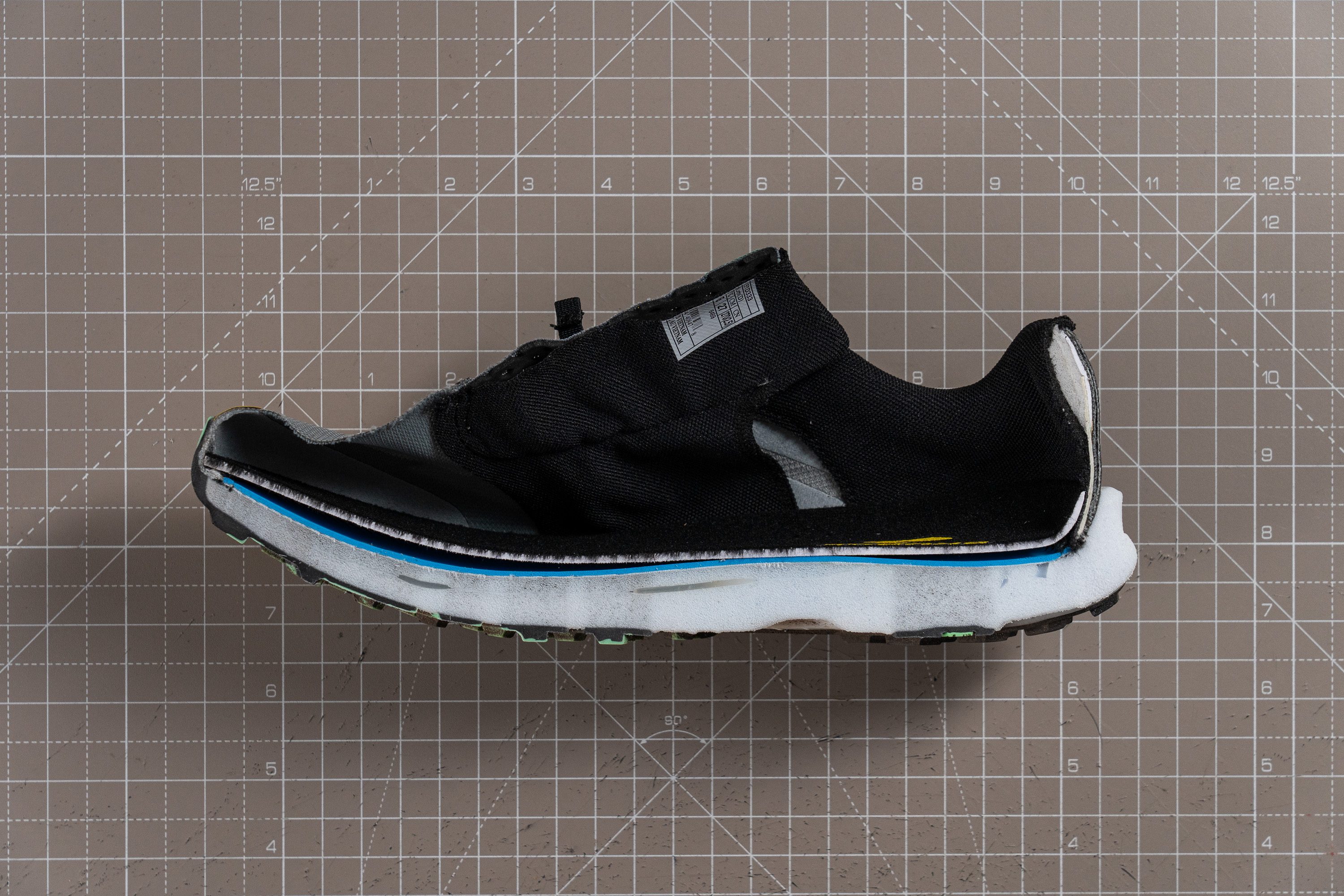
| Catamount 3 | 6.8 mm |
| Average | 7.8 mm |
Insole thickness
To maintain the shoe's lightweight design, Brooks chose a notably thin insole that measures just 2.8 mm. This decision is logical for a nimble shoe designed to deviate from bulkier, maximalist models. After all, why use a typical 5.0 mm insole when striving for agility and weight savings?
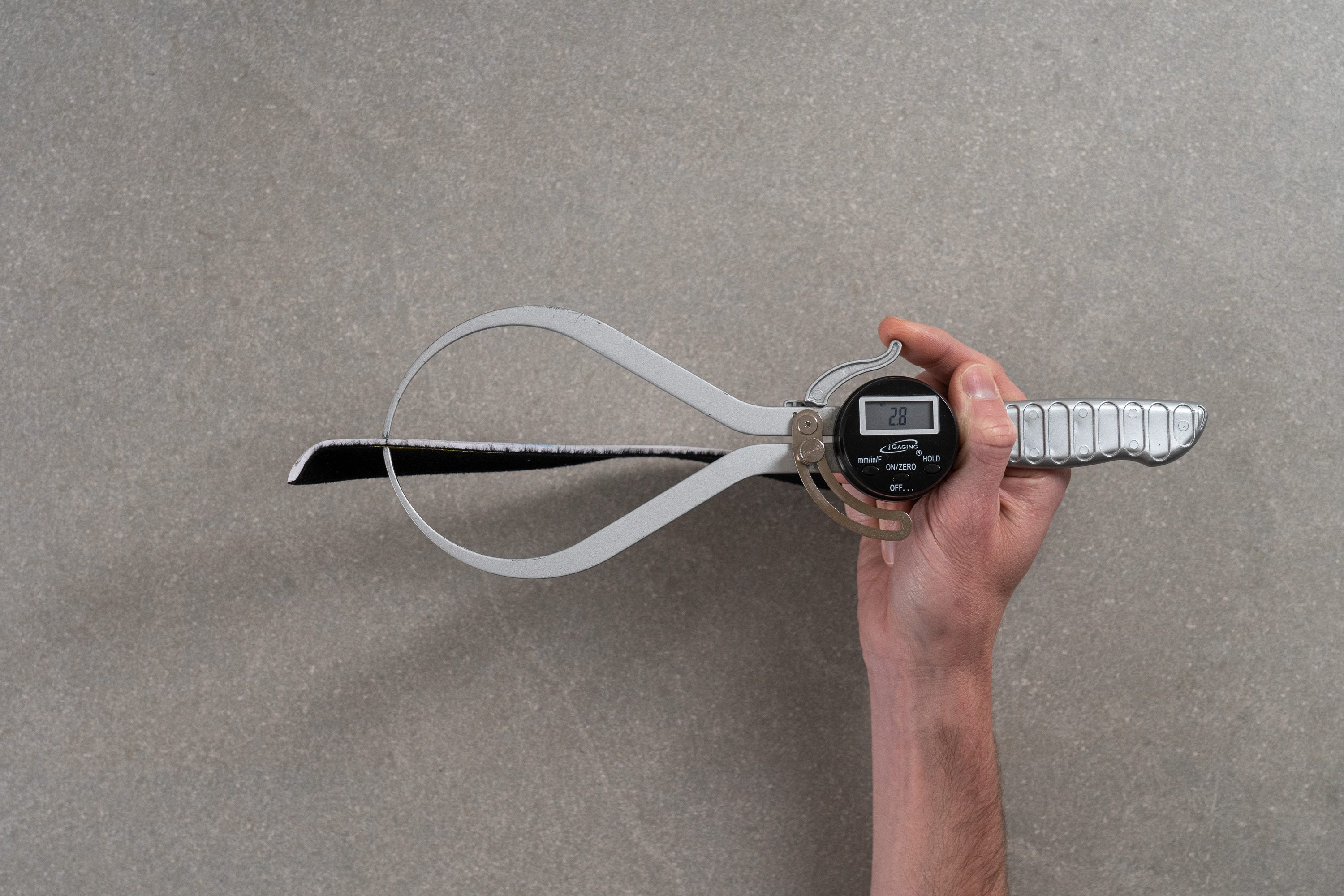
| Catamount 3 | 2.8 mm |
| Average | 4.7 mm |
Midsole softness
Upon examining the midsole of the Brooks model, we found in the lab a slight softening of the nitrogen-infused DNA Flash foam, evidenced by a 20.4 HA measurement from our durometer.
This adjustment results in an ideal compromise for a trail running shoe, offering stability and responsiveness without being overly plush.
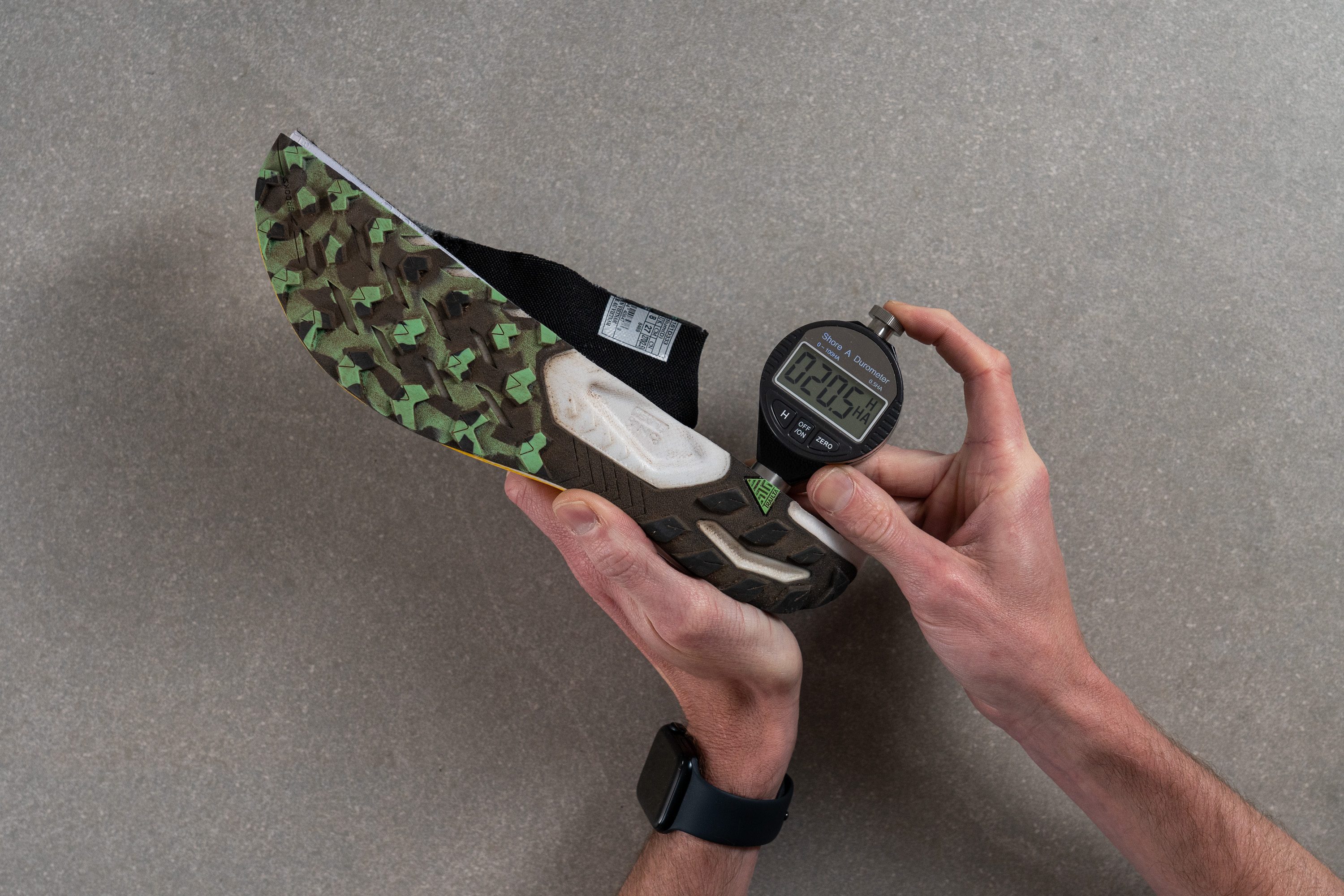
| Catamount 3 | 20.4 HA |
| Average | 23.0 HA |
Difference in midsole softness in cold
Upon spending 20 minutes in the freezer, we observed a 25.1% shift compared to the ambient temperature measurements, a figure that aligns well with typical expectations.
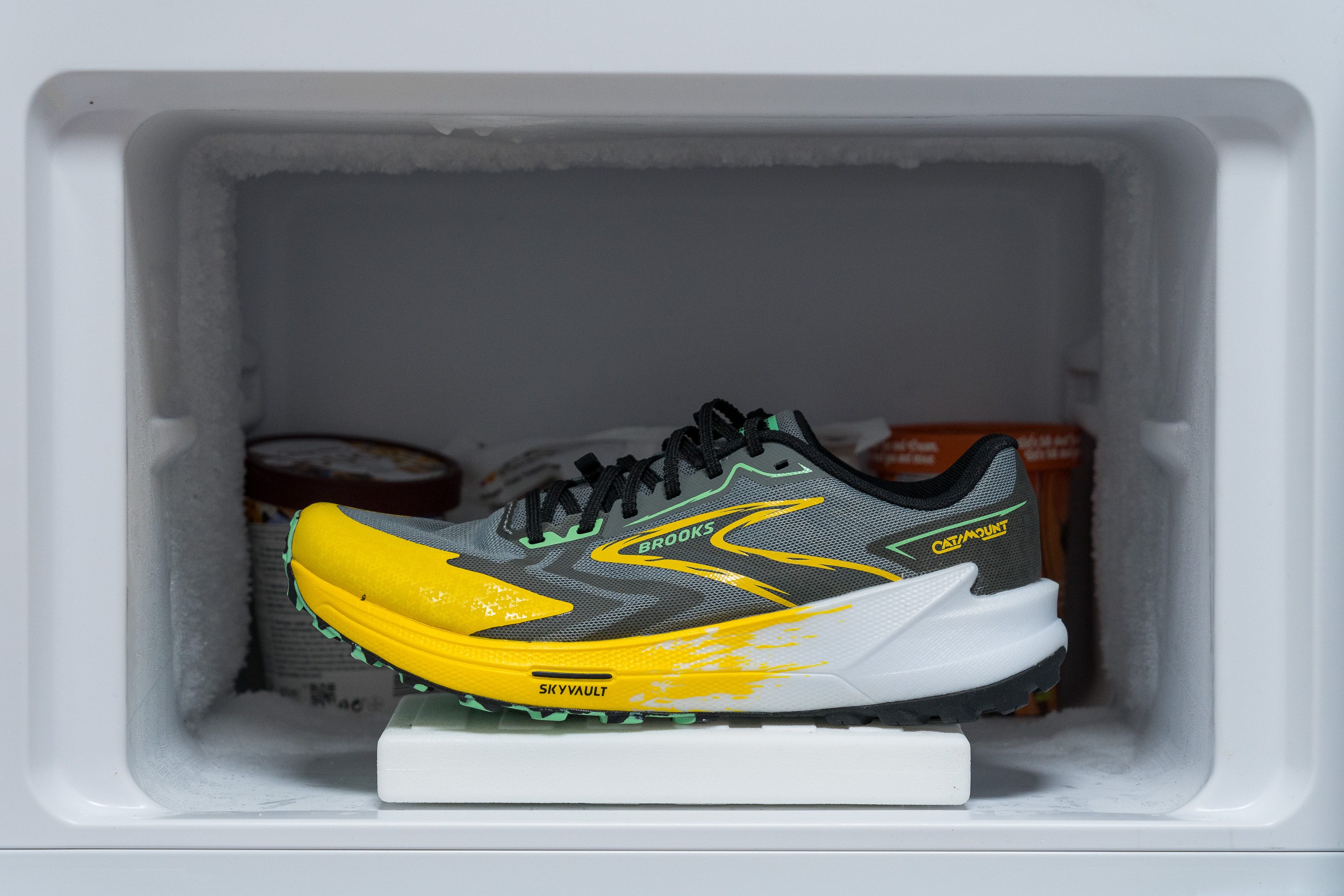
| Catamount 3 | 25.1% |
| Average | 26.8% |
Plate
We confirmed the presence of the same Skyvault partial plate in the forefoot, which notably does not extend to the heel.
This plate serves three critical functions—it enhances stability, acts like a rock plate to protect the feet given the moderately low stack height, and slightly increases the shoe's responsiveness.
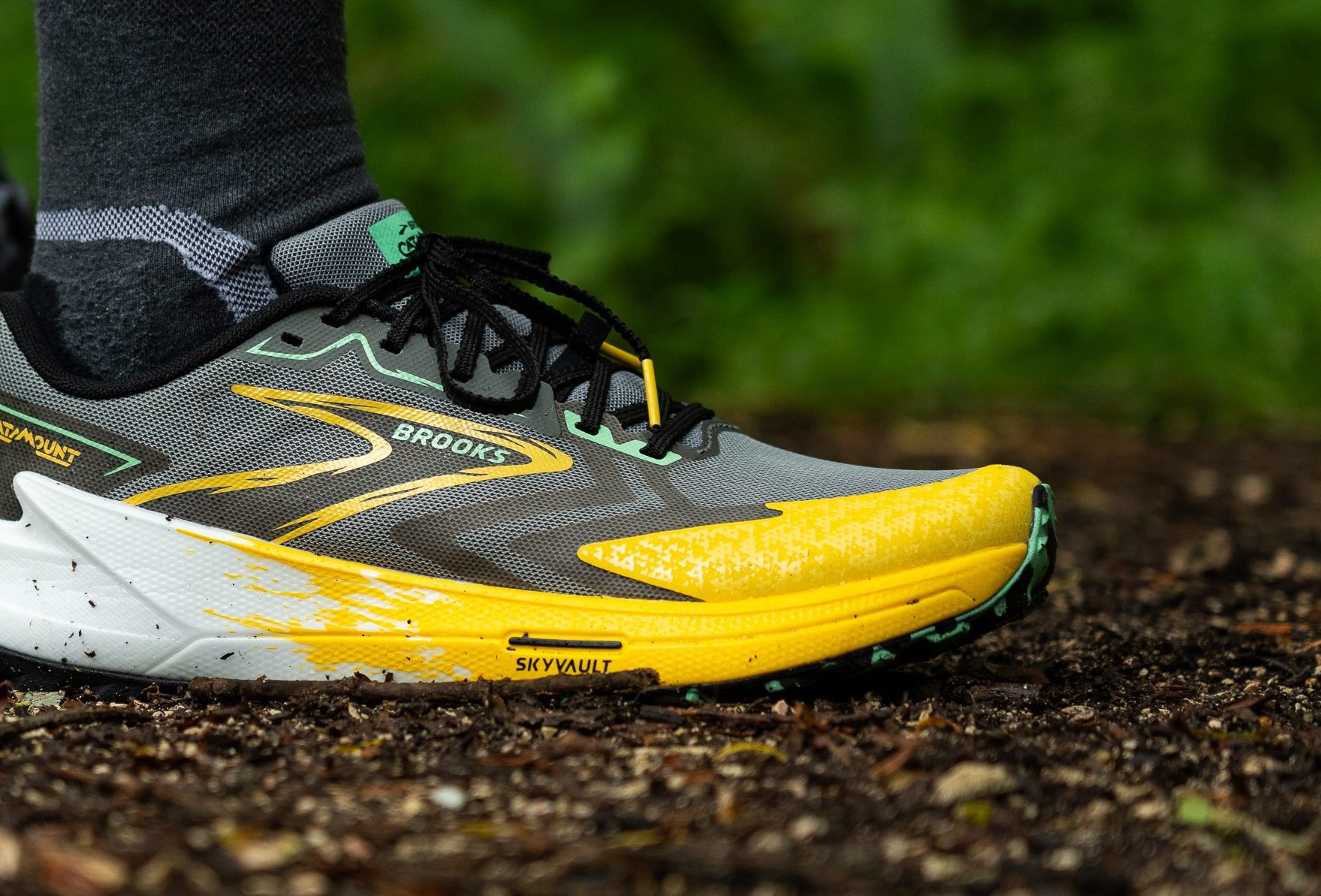
Stability
Lateral stability test
The lower stack height is a significant advantage in trail shoes for enhanced stability.
We've confirmed that this model maintains the same secure, close-to-ground feel that made its predecessor a favourite. While there's a bit less cushioning, the improvement in performance on technical trails and winding paths is notable, partially thanks to the midsole sidewalls that extend from the midfoot to the heel.
Torsional rigidity
It appears that Brooks took the feedback on the Catamount 2's 5-out-of-5 rigidity to heart. Our recent tests showed a significant change, with the v3 now boasting enhanced flexibility—earning a 3/5 in our lab analysis.
This change makes it much more suitable for technical terrain and increases overall comfort.
| Catamount 3 | 3 |
| Average | 3.5 |
Heel counter stiffness
The revised heel counter in the latest update has a softer feel, rating it a 2/5 for firmness.
Despite this, it remains adequately supportive, offering the minimal stability and security that heel strikers rely on.
| Catamount 3 | 2 |
| Average | 3.2 |
Midsole width in the forefoot
The Catamount 3 maintain its distinctive ride experience, unchanged due to the consistent dimensions.
Our measurements revealed a forefoot width of 115.3 mm—remarkably broad given the shoe's lightweight design. We think that this wide platform contributes significantly to the shoe's nimble yet stable feel.
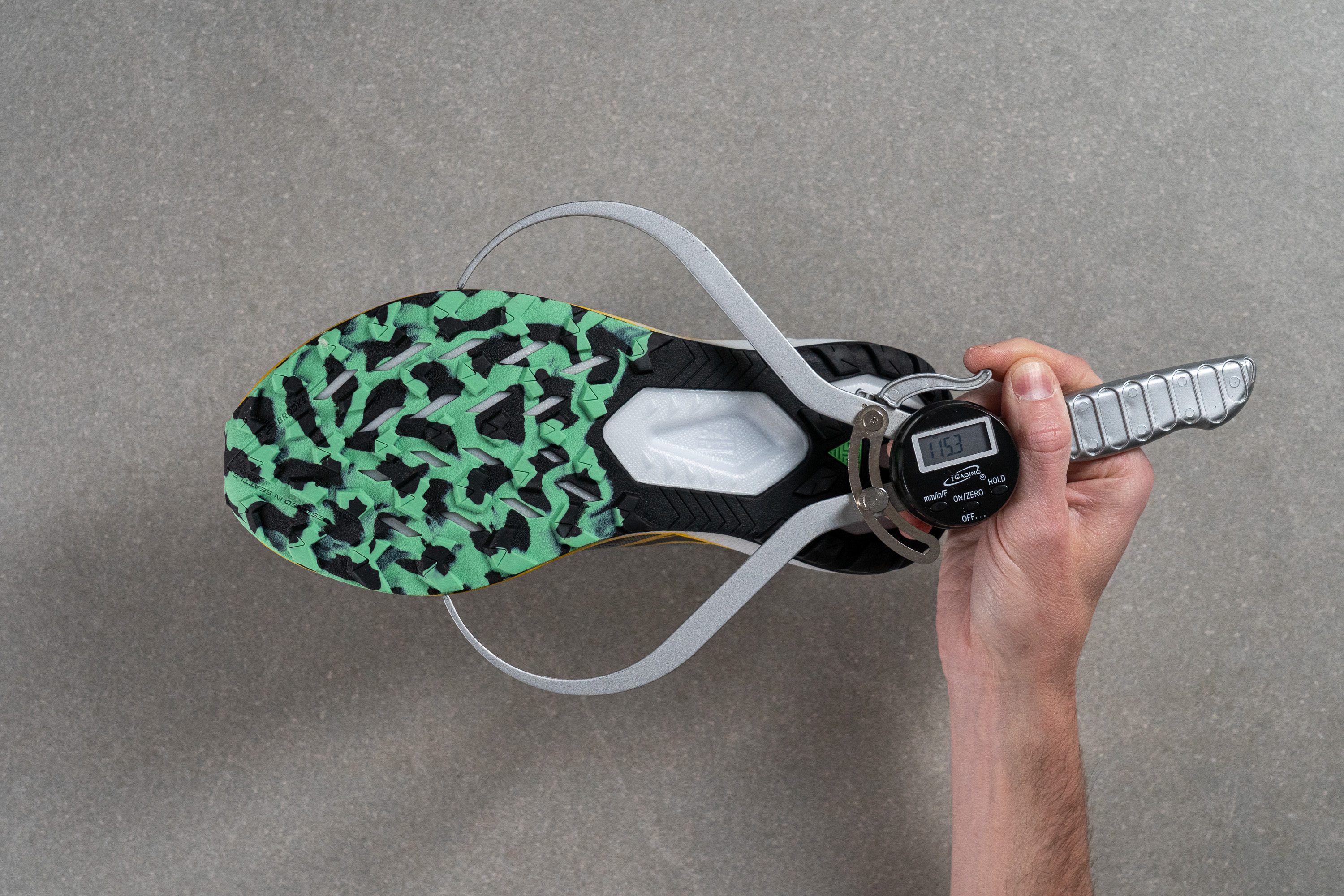
| Catamount 3 | 115.3 mm |
| Average | 111.9 mm |
Midsole width in the heel
The heel width measures a standard 91.4 mm, aligning with what one typically finds in most daily trainers designed for road running.
This dimension highlights why we particularly recommend this shoe for forefoot and midfoot strikers.
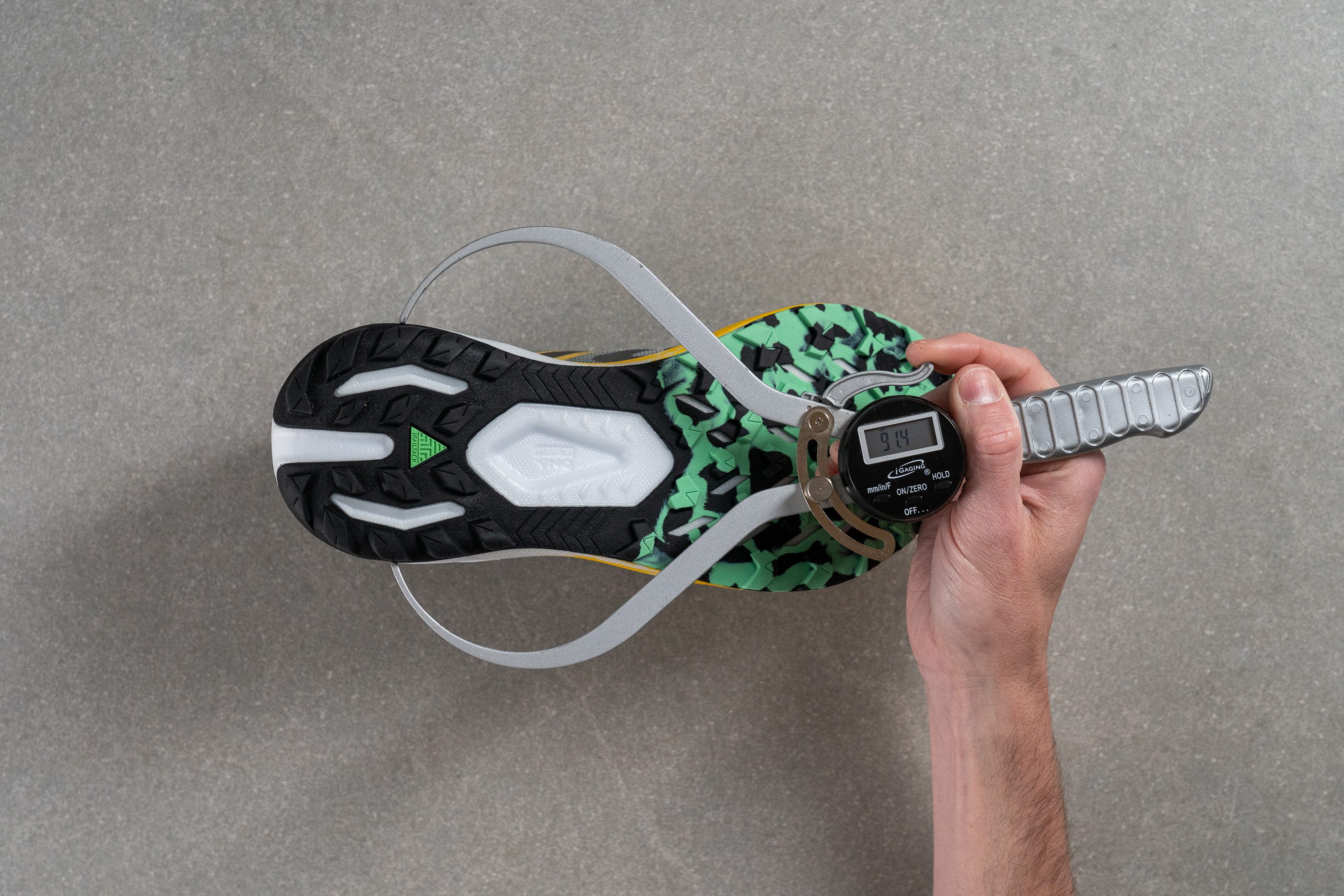
| Catamount 3 | 91.4 mm |
| Average | 89.6 mm |
Flexibility
Stiffness
We've demonstrated a reduction in torsional rigidity compared to its predecessor, but how does it fare in lengthwise flexibility?
Our findings show that Brooks has successfully made the shoe less stiff, as evidenced by our 90-degree bend test which required only 22.5N, going south from the previous 29.1N. We view this change positively as it makes the Catamount 3 a more adaptable and better at technical terrain.
| Catamount 3 | 22.5N |
| Average | 28.4N |
Difference in stiffness in cold
After subjecting the Catamount 3 to a 20-minute stint in the freezer, we tested its flexibility again and were notably impressed. The shoe demonstrated only an 18.1% increase in stiffness, showcasing excellent cold-weather performance!
| Catamount 3 | 18.1% |
| Average | 35.3% |
Grip / Traction
Lug depth
The tread pattern on the Catamount 3 features shallow 2.9 mm lugs, falling below the average depth observed in all our lab-tested shoes.
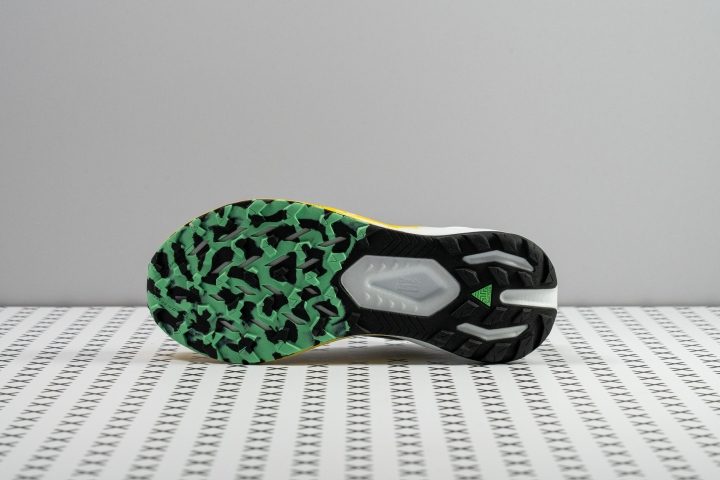
Despite this, such a lug depth is optimal for a fast trail shoe and proves to be exceptionally effective on hard surfaces like gravel roads. The Catamount 3 ensures a smooth, fast ride that excels on compact terrain.
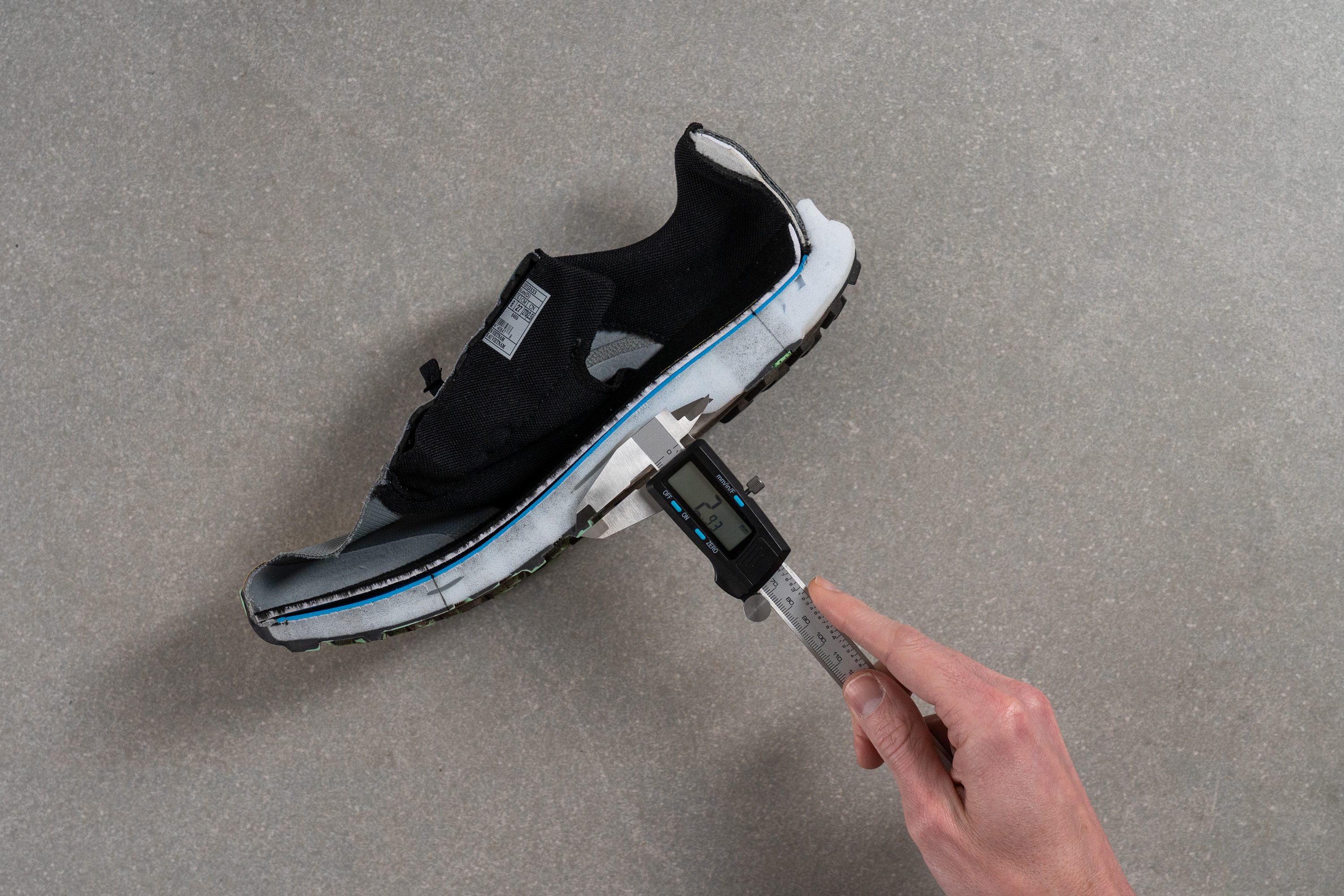
| Catamount 3 | 2.9 mm |
| Average | 3.6 mm |
Size and fit
Toebox width at the widest part
One feature that consistently polarises opinions in every Catamount is the fit, and we've confirmed that it continues to offer the same competition-like, snug fit in the metatarsals.
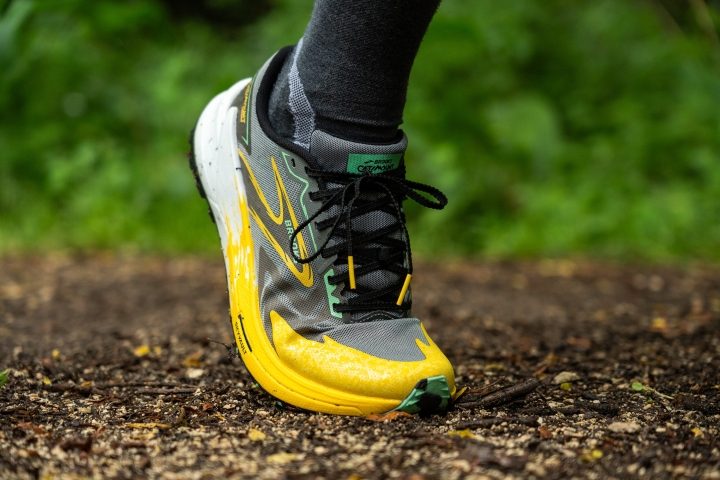
This is ideal for those who prefer a secure lockdown and don't mind some extra snugness, particularly beneficial for trail runners with narrow feet. However, with a width of 95.6 mm at the widest part of the toebox, this fit is not suitable for those with wider feet.
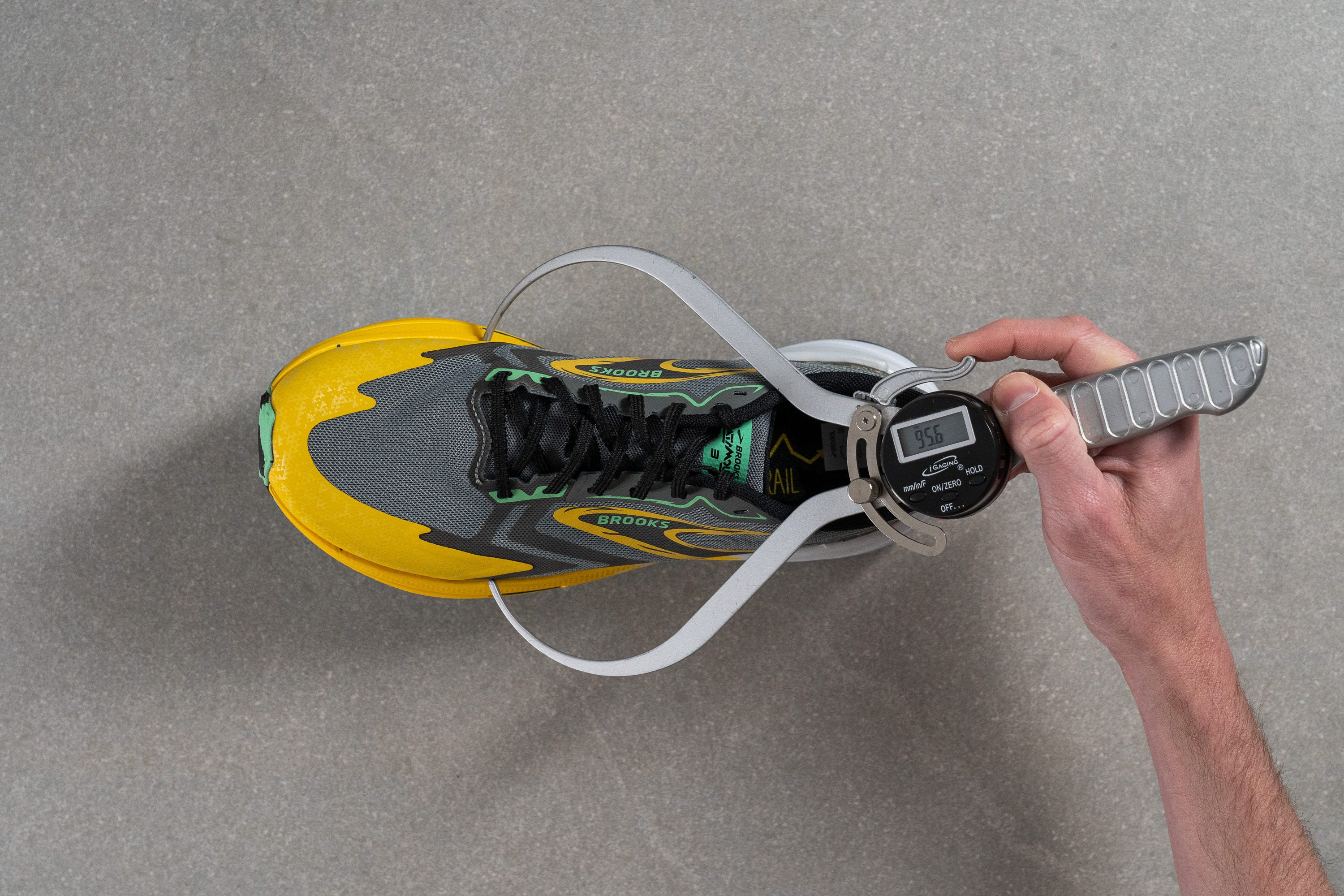
| Catamount 3 | 95.6 mm |
| Average | 98.7 mm |
Toebox width at the big toe
However, the Catamount offers some hope for individuals with wide feet.
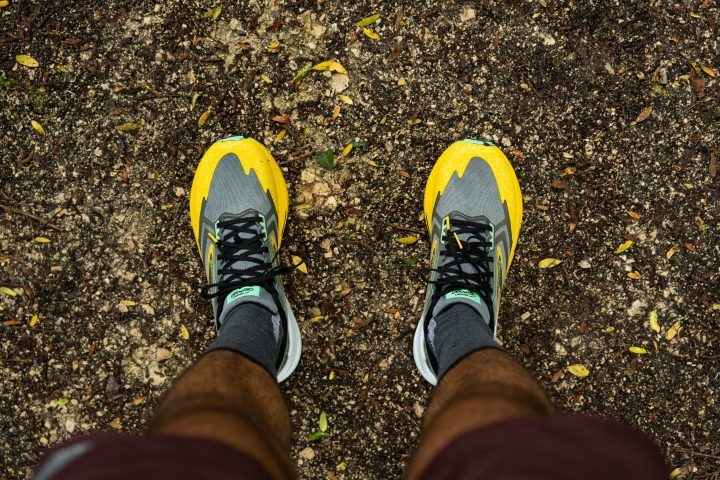
How so? Brooks has cleverly designed a generous rounded toe cap, which we measured at 80.8 mm. This thoughtful design allows for ample toe splay while still delivering the snug fit that fans of the Catamount expect.
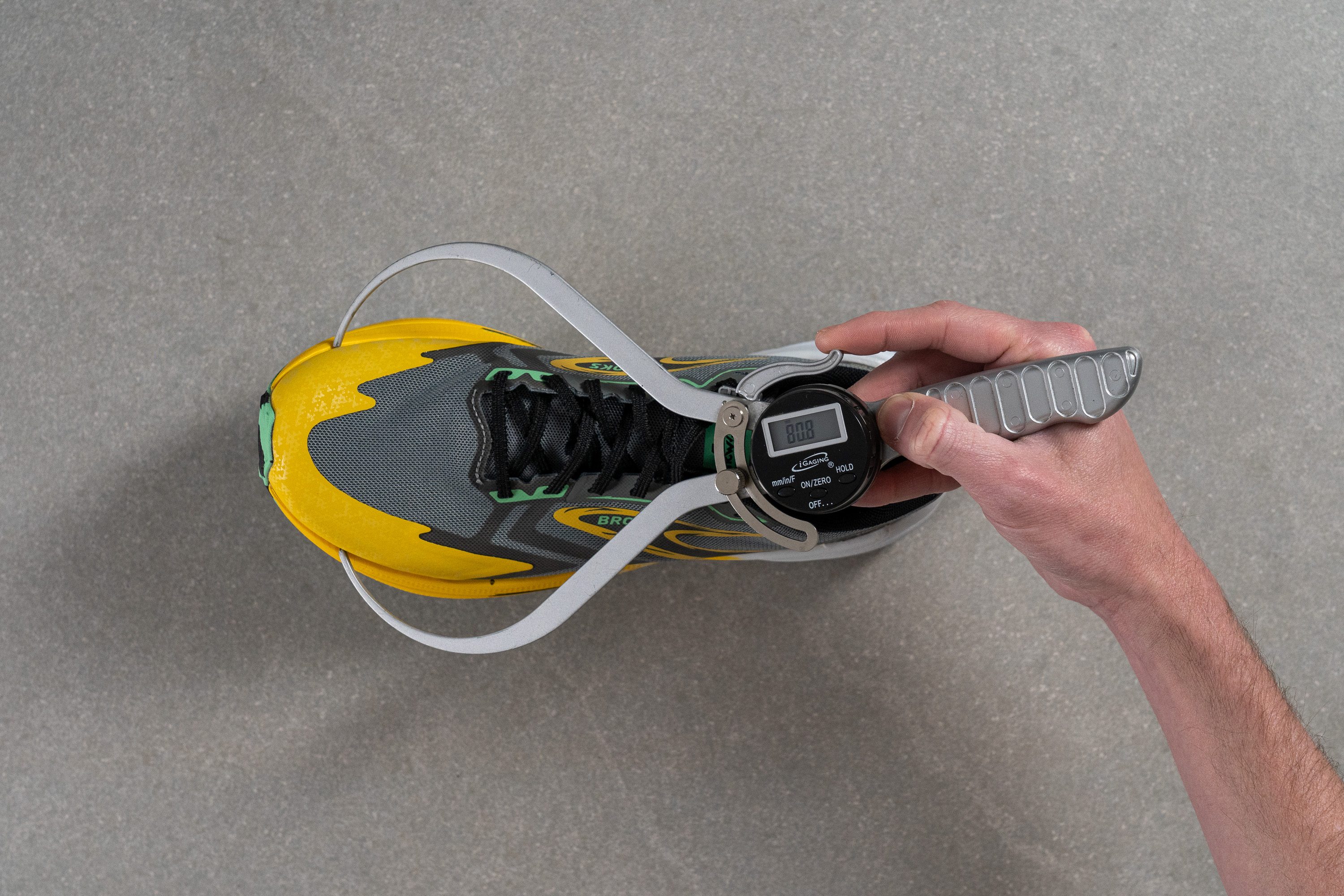
| Catamount 3 | 80.8 mm |
| Average | 79.0 mm |
Tongue: gusset type
At a retail price of £180, we naturally expect features like a gusseted tongue in a trail running shoe, as it effectively keeps debris out of the toebox. Fortunately, we were pleased to discover that the tongue is indeed fixed to the sides.

| Catamount 3 | Both sides (full) |
Comfort
Tongue padding
The tongue, maintained similar to v2 at just 3.4 mm, continues to offer a balance of comfort and lightness that we find ideal for a shoe like this.
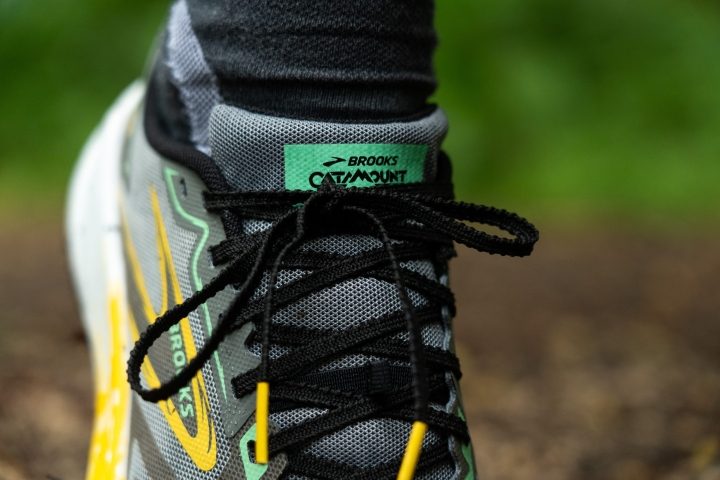
We were impressed by the inclusion of notched laces, a feature typically reserved for higher-end, road racing shoes. This is a fantastic detail that enhances the Catamount experience.

| Catamount 3 | 3.4 mm |
| Average | 6.4 mm |
Heel tab
Like its predecessor, the Catamount 3 lacks a heel tab, but disappointingly, we also discovered the removal of the ankle gaiter attachment point, which was a useful feature in the previous model. This omission represents a step back in functionality.
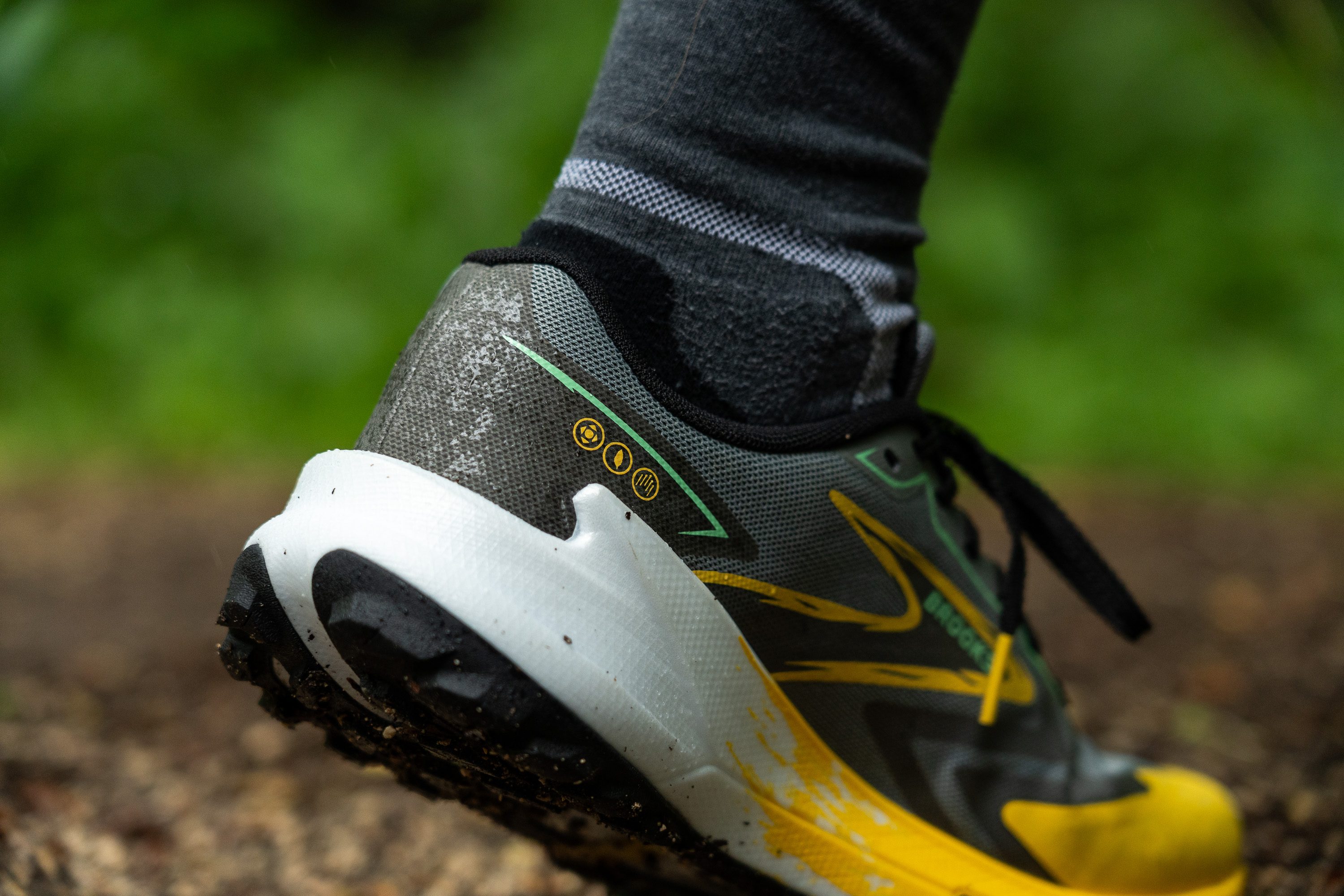
| Catamount 3 | None |
Removable insole
The removable and perforated insole, a highlight of the Catamount 2, has thankfully been retained in this third iteration.
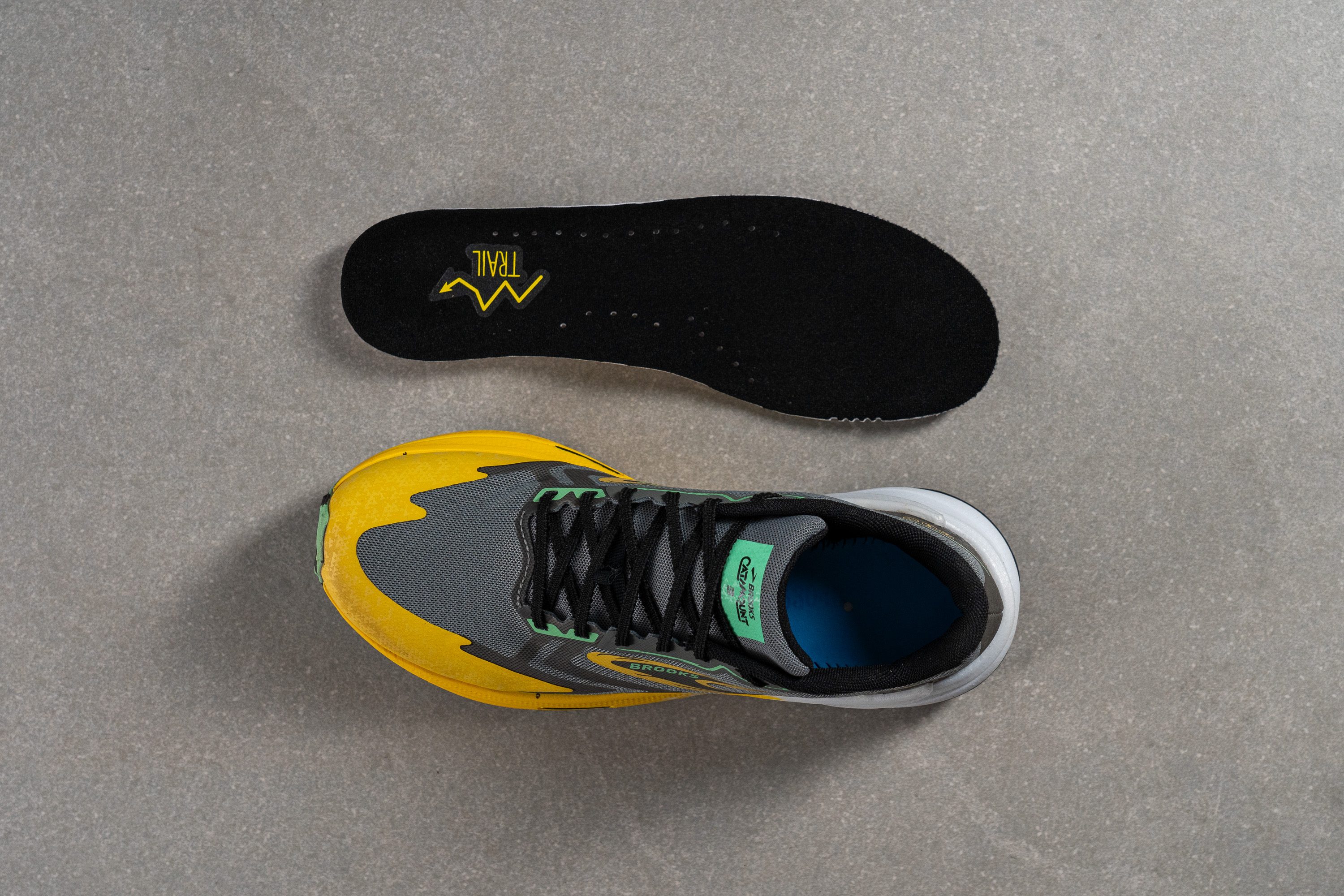
| Catamount 3 | Yes |
Misc
Reflective elements
Our lab team discovered that the Catamount 3 lacks reflective elements, a significant disappointment for those who prefer running in low-light conditions.
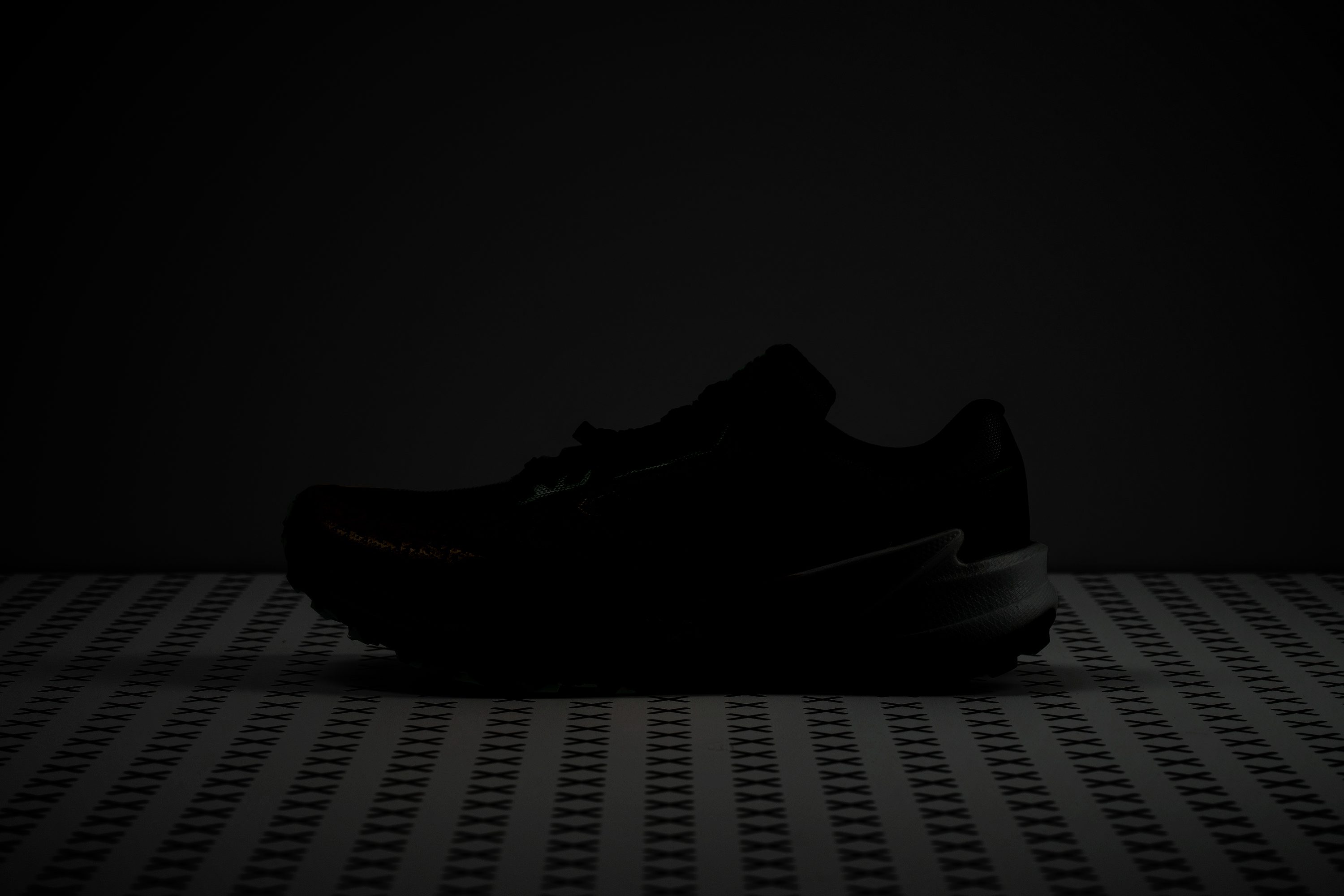
| Catamount 3 | No |

